Try this homemade 100% palm oil soap recipe at home. Palm oil is a very complete fat, pretty much like lard. It makes for a mild, moisturizing soap bar, with very good hardness and light, but stable foam.
However, palm oil is controversial nowadays. You will find many soap making blogs listing specifically palm oil-free recipes, refusing to use palm oil in their soap recipes. Why? And why on earth one of them presents a 100% palm oil recipe? Well… Keep reading, and you’ll find out.
Table of Contents
Can You Make 100% Palm Oil Soap?
This is an easy one-fat homemade soap recipe, made with 100% palm oil. Palm oil is a very complete fat for soap making, pretty much like lard. And, in my opinion, it has a bad undeserved reputation. In general, I love one-fat soap recipes. They are very simple to make: one oil, lye and water, and you don’t need anything else. They are perfect for soap making beginners.
Of course, like the next soapmaker, I like to experiment with oil mixtures. But there’s something about one-fat soap that attracts me. I suppose it’s because of its simplicity. And if it’s a locally produced oil, cheap and of good quality, it’s the most logical choice.
During my research for lard and palm oil recipes, and one-fat soap recipes, I’ve stumbled upon this post, http://www.zensoaps.com/singleoil.htm. You can actually make a lot of one-fat soaps, some working better than others. I definitely plan to experiment on many of these single oil recipes. This is probably the forth one-fat soap recipe I try – with success.
Is Palm Oil Good for Soap Making?
Palm oil on its own makes for a mild, moisturizing soap bar, with very good hardness, good lathering and light foam. Paired with other oils, coconut oil and olive oil for example, it creates a very complete soap bar (see Cold Process Soap Recipe with Layers).
However, this is a controversial ingredient, due to environmental issues related with deforestation and species endangerement. The generalized use of palm oil in food and cosmetic products has attracted the concern of environmental groups. The high oil yield of the trees has encouraged wider cultivation, leading to the clearing of natural habitat forests in parts of Indonesia to make space for oil-palm monoculture.
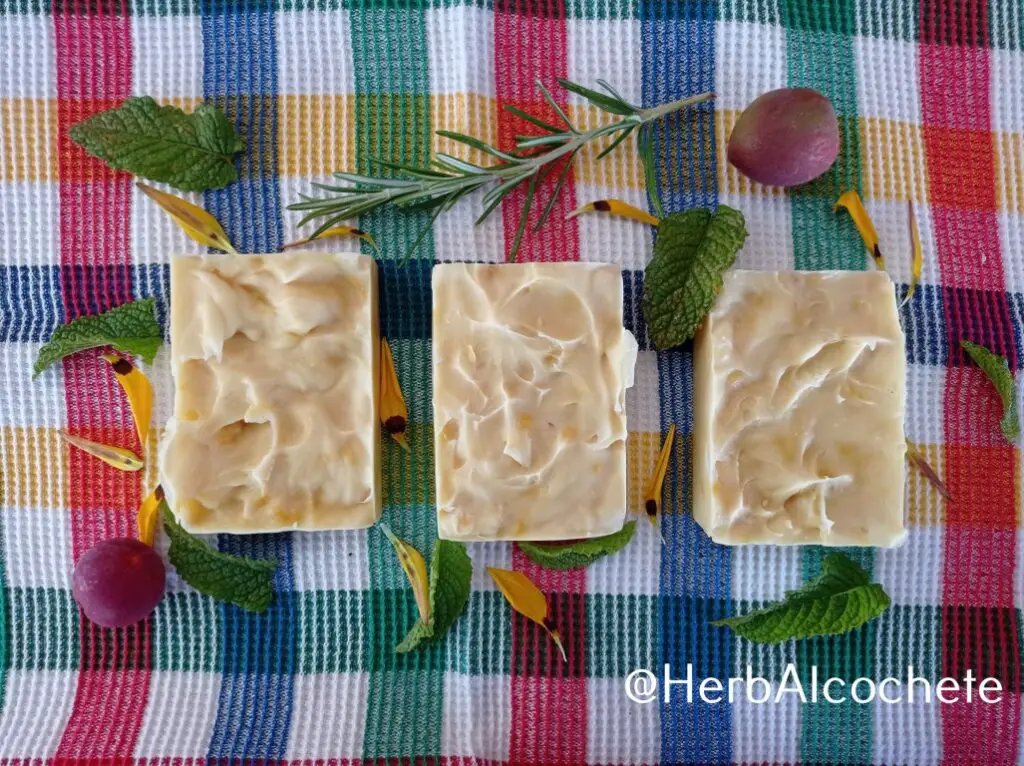
Therefore, many soap makers have started to eliminate the usage of palm oil. But this is not a solution to the environmental problem.
What Is The Biggest Problem With Palm Oil?
Palm oil is not harmful in itself. The biggest problem with palm oil is its widespread cultivation in some countries due to its worldwide consumption. This has been the main reason for uncontrolled deforestation of some of the world’s most biodiverse forests, destroying the habitat of already endangered species.
However, palm oil by itself is a good vegetable product with a high yield. It means one can produce a lot of oil with fewer resources compared with other plants. The problem is related with the governments exploring palm oil cultures, and not exactly the culture of palm oil in itself.
That’s why several producers felt the need to create an association that produces sustainable palm oil, the Roundtable of Sustainable Palm Oil was created. Whenever you wish to use palm oil, make sure it’s from a producer from this association. You will be buying palm oil from sustainable and ethical producers.
I’d strongly advise you to read these articles about the subject:
- https://www.wwf.org.uk/updates/8-things-know-about-palm-oil
- https://lovelygreens.com/avoiding-palm-oil-in-soap-making/
- https://www.mygreenpod.com/articles/palm-oil-in-beauty/
- https://www.soapqueen.com/business/on-palm-oil/
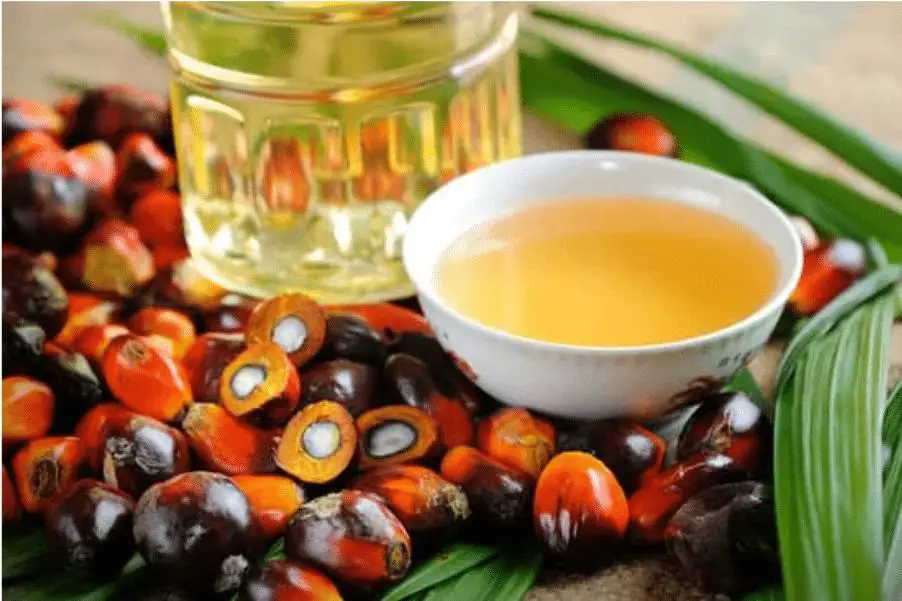
Now, in my humble opinion, why soap makers should not ban palm oil from their recipes?
First, palm oil used in handmade soap might not even be representative in the worldwide consumption number. Even the cosmetic industry, just represents 5%-10% of it. So, avoiding to use it in homemade soap won’t make any difference in the big picture.
Second, palm oil is one of the few accessible food ingredients for the population of many countries without so many resources as western ones. Third, the internet is still a free or cheap resource available to more than half of the world population. Soap making is a relatively cheap business area, that can be an income complement, or even the only one, for many families with economical dificulties. With internet available, and using available local resources – like palm oil – some families can improve their life.
By not posting palm oil soap recipes, we are simply disabling a valuable resource to many families with scarse resources for a start. I am publishing this palm oil soap recipe as an attempt to help others with fewer resources than myself. To tell that they can make soap, for their own use or even to make a business out of it, with not much than lye, water and palm oil.
Please, see a comment from my Youtube Channel regarding this recipe, that says it all:
Thank you. Finally, I found a recipe to use only palm oil. Other type of oil in is much pricey compared to palm oil. And for underprivileged families, it is a matter of providing alternative. Nowdays, babies also have skin problems. These families can’t afford to seek help from specialist doctor or even buy ‘gentle’ formulated soap.
Jannah Marooskin, from HerbAlcochete YouTube Channel
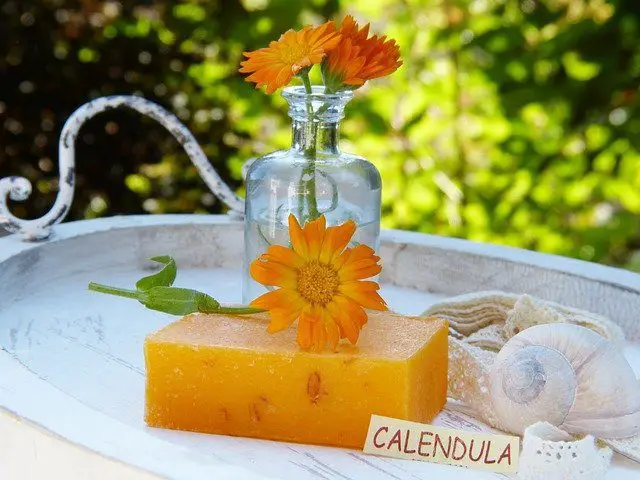
How Do You Make Palm Oil Soap?
Palm oil soap is made with lye, water and palm oil only, as it was alreayd suggested before. Palm oil makes for a very good, balanced soap, hard, mild, moisturizing and fairly good with foam. But I have used other ingredients for this recipe to make the soap more pleasant and attractive.
Is it affordable? By avoiding the essential oil, the soap only depends on the price of lye and palm oil, as you can color the soap with plant ingredients, such as calendula, carrots or turmeric. It can be as cheap as that.
some space to talk about the other main ingredient of this recipe – calendula.
Calendula
I’ve used calendula to color this soap with a beautiful yellow and speckles of orange. Calendula is a well-known herb and uplifting ornamental garden plant that has been used topically, ceremonially, and as a dye and food plant for centuries.
This recipe uses calendula dried petals as the natural colorant added to the lye water. Some of the dried petals are used whole as decoration.
Essential Oils Blend
I wanted to make an experiment and see how ylang -ylang III essential oil behaves on its own in soap. So this is the essential oil used for soap fragrance. However, you can use your favorite essential oil for soap, or a blend of your choice. Some suggestions:
- Lemongrass (60%) and Cedarwood (40%) essential oil blend
- Litsea Cubeba/May Chang essential oil
- Lavender (4), Ylang Ylang III (1) and Benzoin (1) essential oil blend
Making Soap for Beginners
This is a great soap recipe for beginners, especially to learn about fast tracing and how to deal with hard oils in soap making. Similar to How To Make Coconut Soap and Homemade Lard Soap Recipe, this soap traces quite fast when you are using the stick blender. You might pass liquid trace without even realizing.
Because you only have to add the anti-oxidant and the essential oil afterwards, it’s relatively easy to save if you get distracted. Most likely you will pour this soap batter into your molds with a spoon 🙂
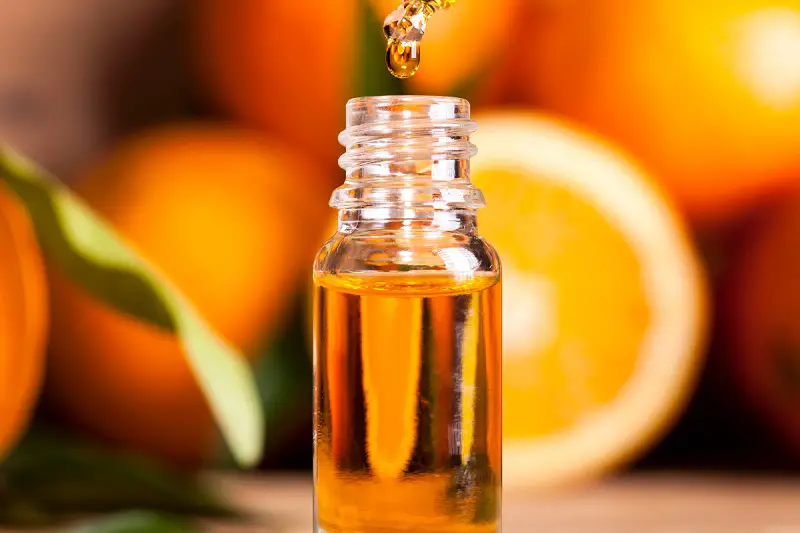
Other Palm Oil Soap Recipes
If you’re looking for more recipes with palm oil (this time in a mixture) check out the following links:
- Homemade Rosemary Soap
- Patchouli Soap Recipe
- Cold Process Soap Recipe with Layers
- Layered Lavender Cold Process Soap Recipe
- Rosemary and Eucalyptus Soap Recipe
How To Use This Soap
In the shower or bath, wet your hands and rub your soap in them to create a lather. Wash your hands first, then repeat the process and apply soap to your whole body using the soap directly and your hands. You may also wash your face with it. Rinse hands and body abundantly. Also wash your soap from lather before placing it in your soap dish or bag saver.
Washcloths and sponges should be avoided. Avoid washing your intimate zone and your hair, soap pH in not adequate for those parts of your body. Avoid eye contact with soap to prevent stinging. Make a patch test before using your soap. Stop using your soap if you feel any immediate adverse reaction in your skin (red skin, rashes, itching).
To take best advantage of your handmade soap (made by yourself or store-bougth), read How Do You Use Handmade Soap?
Related Posts
Ingredients and Recipes
- Vegetable oils: Oil Properties For Soap Making
- Essential oils: Best Essential Oils for Soap Making
- Colorants: How To Color Your Soap With Kitchen Ingredients
- Beginner Recipes: Soap Recipes for Beginners
- Cold Process Soap Recipes: Free Cold Process Soap Recipes
Soap Making Techniques and Troubleshooting
- Cold Process Tutorial Guide: Learn To Make Cold Process Soap?
- Soap Making Methods: How To Make Soap At Home
- Soap Making Trace: Know Everything About Trace in Soap Making
- Soap Acceleration: Causes, How To Avoid It Or How To Fix It
- Soda Ash In Soap: What It Is, How to Remove It
Watch This Video About Safety
Cold Process Soap Making Tutorial Video
Cold Process Soap Making Lessons
The tutorials in this blog are a great – and free! – help to start with cold process soap making. Practice is the next step to harness the art of making soaps at home. However, I understand if you prefer to have some formal lessons, where you will feel more supported with the steps. Feel free to join these courses at Udemy.
Equipment
Ingredients
Lye Water
- 66 g distilled water
- 28 g lye (100% sodium hydroxide)
- 1 tsp dried calendula petals
Oils/Fat
- 210 g RSPO palm oil
Add After Trace
- 4 drops grapefruit seed extract (GSE) (anti-oxidant)
- 6,5 ml essential oil litsea cubeba/may chang or other (optional)
- alcohol or witch hazel to sprinkle recommended to avoid soda ash
Decoration
- dried calendula petals whole or in powder
Instructions
Get Ready!
- Wear goggles and gloves! Look at “Safety Recommendations” in the video above or in How to Make Soap From Scratch
- Watch the video above about "Cold Process Soap Making tutorial" or read the post How To Make Soap by Cold Process Step-by-Step for instructions on cold process soap making before starting. These are generic but important steps for all recipes.

- Assemble everything: ingredients, equipment, safety equipment. Prepare your workstations. Measure all the ingredients. Don’t start the recipe without having everything ready!
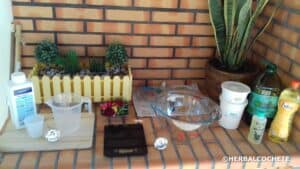
- The essential oil is optional. It adds scent to your soap. You can choose the one from the recipe or another like lavender, peppermint, eucalyptus, lemongrass. You can also choose a fragrance oil. But do not exceed the 6,5 ml limit. Your soap will be really cheap if you skip this.
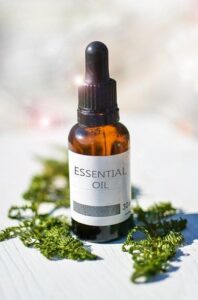
Heat the Oils
- Melt the palm oil as it remains solid at room temperature.
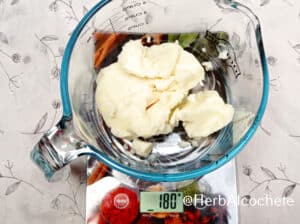
Make the Lye Water
- Make the lye solution according to How To Make Lye Water. Mix it until the vapors start to dissipate. Add the dried petals at the end.

Make the Soap Batter
- Use as target temperature 28ºC for the oil-solution mixture. If necessary, heat the palm oil a little.
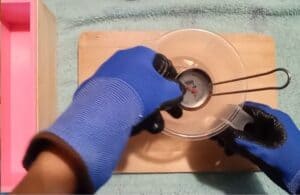
- Reach trace with the immersion blender. You will reach trace very, very fast, be ready.

- Add the extract, essential oil and calendula dried petals/powder after tracing. Mix with a spoon. Be swift with this operation and molding.
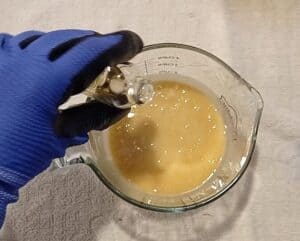
Molding and Curing
- Pour the dough in the molds with a pitcher and sprinkle with alcohol or witch hazel.
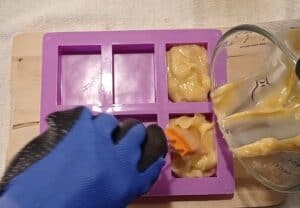
- Let it set for 48 hours.
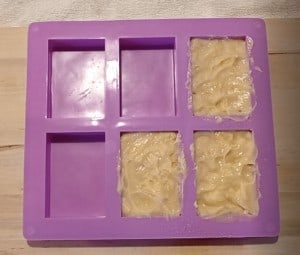
- Unmold and let the bars cure for 4 to 6 weeks. See How To Cure Soap.
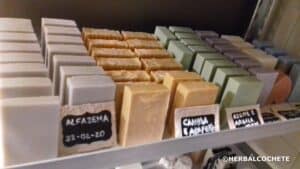
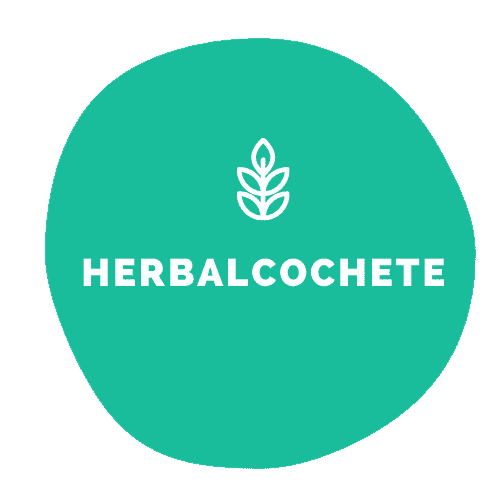


I love that picture there at the start. It makes you want to bite into it. I love the artistic way lotys of soap nowadays looks like confectionery. Palm oil is definitely a great product for making soap with and youve done a great job of highlighting this here. Thanks for sharing this article. It’s been educational.
Hello Kwidzin.
Haha, I don’t advise you to eat it, no matter how edible it looks 😀 But this is the beauty of it. This is nothing but lye, water, palm oil and calendula petals!! And you have a great-looking soap!
Yes, I believe someone needs to state that palm oil, by itself, it’s good!! And given the fact that the cosmetic industry represents as little as 1% of worldwide palm oil production, and that handmade soap are much, much less than that, I don’t understand the generalized “ban” on palm oil in soap recipes. What we should do is encourage the usage of RSPO palm oil, and use this great ingredient in handmade soap more often.
Thanks for your comment and interest in palm oil soap!
Sofia
hey there Sofia,
Great post and thank you so much for those great soap recipes. I always wanted to try making soaps bu i had no idea how to or where to start. My wife loves buying fancy soaps and i think it will be a real surprise if i could make her a few soaps.
Thank you again for the great tips, it will really come in handy.
Regards
Lawrence
Hello Lawrence and thanks for your interest in soapmaking!
Although I usually advise against it, as soap doesn’t really need fancy smells to be great, if you want to impress your wife, buy a good quality fragrance oil (to be good you should spend around $4/10 ml. Cheap ones tend to be very artificial) with your wife’s favorite scent, and use it on your soap 🙂 just use up to 3% or follow the manufacturer’s instructions.
As for the soap itself, you can definitely use this palm oil soap, or this recipe of How To Make Coconut Soap. Just switch the essential oils there with your fragrance.
Hope your surprise to your wife goes well!
Cheers,
Sofia
This post is very informative and educative, I never knew you can make soap with palm oil. It also has many other benefits, like; supports eye health, improves blood circulation, rich in vitamin K and many other things. You can even cook with it as well. I am going to try some soap recipe which you listed.
Hello Dozzy, thanks for your comment and the useful information.
I am glad you liked this post about palm oil soap. Actually, not only you can make soap with palm oil, this is actually a very common ingredient even in commercial soaps: sodium palmate, or sodium palm kernelate (this last one is made with palm kernel oil). I can even go as far as to say that you can make soap with ANY fat, vegetable or animal 🙂
I didn’t know that palm oil was rich in vitamin K. As far as I know that vitamin is very good to fight under-eye dark skin. Palm oil seems to be good as well for an eye serum 🙂 I’ll try to remember this for the next time I make an eye serum. This is my current recipe: Homemade Eye Serum for Dark Circles.
Thanks for the info.
Cheers,
Sofia
Glad you recommended the RSPO palm oil in your post! Thanks for highlighting the numerous benefits of palm oil in our society! I can’t do without using palm oil as a soup ingredient. It’s an important material for soap making. Palm oil is useful for correcting our sight. It should be moderately taken and can bring many yields, to be precise. The use of palm oil is immeasurable to mankind. It’s better for consumption than groundnut oil. It doesn’t have side effects,unlike groundnut oil. Thanks.
Joyce
Hello Joyce and thanks for your comment.
Indeed, and similar to lard, palm oil has an undeserved bad reputation. In case of lard, it’s because it’s an animal fat, in case of palm oil is due to the related environmental problems. Both fats are very good (they are actually similar in its fatty acid profile), great for soap and good for your diet, as long as you keep its consumption moderate.
I am glad there are more people that think that palm oil should be used – especially when there’s a certification (RSPO) that guarantees sustainable and ethical production practices, which is more than you can say about many other oils.
Cheers,
Sofia
Good post. I learn something new and challenging on sites I stumbleupon every day. It will always be useful to read through articles from other authors and practice a little something from other websites.